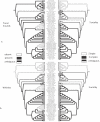Phylogenetic review of tonal sound production in whales in relation to sociality
- PMID: 17692128
- PMCID: PMC2000896
- DOI: 10.1186/1471-2148-7-136
Phylogenetic review of tonal sound production in whales in relation to sociality
Abstract
Background: It is widely held that in toothed whales, high frequency tonal sounds called 'whistles' evolved in association with 'sociality' because in delphinids they are used in a social context. Recently, whistles were hypothesized to be an evolutionary innovation of social dolphins (the 'dolphin hypothesis'). However, both 'whistles' and 'sociality' are broad concepts each representing a conglomerate of characters. Many non-delphinids, whether solitary or social, produce tonal sounds that share most of the acoustic characteristics of delphinid whistles. Furthermore, hypotheses of character correlation are best tested in a phylogenetic context, which has hitherto not been done. Here we summarize data from over 300 studies on cetacean tonal sounds and social structure and phylogenetically test existing hypotheses on their co-evolution.
Results: Whistles are 'complex' tonal sounds of toothed whales that demark a more inclusive clade than the social dolphins. Whistles are also used by some riverine species that live in simple societies, and have been lost twice within the social delphinoids, all observations that are inconsistent with the dolphin hypothesis as stated. However, cetacean tonal sounds and sociality are intertwined: (1) increased tonal sound modulation significantly correlates with group size and social structure; (2) changes in tonal sound complexity are significantly concentrated on social branches. Also, duration and minimum frequency correlate as do group size and mean minimum frequency.
Conclusion: Studying the evolutionary correlation of broad concepts, rather than that of their component characters, is fraught with difficulty, while limits of available data restrict the detail in which component character correlations can be analyzed in this case. Our results support the hypothesis that sociality influences the evolution of tonal sound complexity. The level of social and whistle complexity are correlated, suggesting that complex tonal sounds play an important role in social communication. Minimum frequency is higher in species with large groups, and correlates negatively with duration, which may reflect the increased distances over which non-social species communicate. Our findings are generally stable across a range of alternative phylogenies. Our study points to key species where future studies would be particularly valuable for enriching our understanding of the interplay of acoustic communication and sociality.
Figures





Similar articles
-
Characteristics of whistles from the acoustic repertoire of resident killer whales (Orcinus orca) off Vancouver Island, British Columbia.J Acoust Soc Am. 2001 Mar;109(3):1240-6. doi: 10.1121/1.1349537. J Acoust Soc Am. 2001. PMID: 11303937
-
The freshwater dolphin Inia geoffrensis geoffrensis produces high frequency whistles.J Acoust Soc Am. 2007 Feb;121(2):1203-12. doi: 10.1121/1.2404918. J Acoust Soc Am. 2007. PMID: 17348541
-
Dolphin whistles: a functional misnomer revealed by heliox breathing.Biol Lett. 2012 Apr 23;8(2):211-3. doi: 10.1098/rsbl.2011.0701. Epub 2011 Sep 7. Biol Lett. 2012. PMID: 21900314 Free PMC article.
-
The social structure and strategies of delphinids: predictions based on an ecological framework.Adv Mar Biol. 2007;53:195-294. doi: 10.1016/S0065-2881(07)53003-8. Adv Mar Biol. 2007. PMID: 17936137 Review.
-
Whistle discrimination and categorization by the Atlantic bottlenose dolphin (Tursiops truncatus): a review of the signature whistle framework and a perceptual test.Behav Processes. 2008 Feb;77(2):243-68. doi: 10.1016/j.beproc.2007.11.002. Epub 2007 Nov 13. Behav Processes. 2008. PMID: 18178338 Review.
Cited by
-
Neuroendocrine mechanisms contributing to the coevolution of sociality and communication.Front Neuroendocrinol. 2023 Jul;70:101077. doi: 10.1016/j.yfrne.2023.101077. Epub 2023 May 20. Front Neuroendocrinol. 2023. PMID: 37217079 Free PMC article. Review.
-
Does size matter? Examining the drivers of mammalian vocalizations.Evolution. 2017 Feb;71(2):249-260. doi: 10.1111/evo.13128. Epub 2016 Dec 13. Evolution. 2017. PMID: 27882540 Free PMC article.
-
Multimodal imitative learning and synchrony in cetaceans: A model for speech and singing evolution.Front Psychol. 2023 Apr 11;14:1061381. doi: 10.3389/fpsyg.2023.1061381. eCollection 2023. Front Psychol. 2023. PMID: 37138983 Free PMC article. Review.
-
Head adaptation for sound production and feeding strategy in dolphins (Odontoceti: Delphinida).J Anat. 2021 May;238(5):1070-1081. doi: 10.1111/joa.13364. Epub 2020 Dec 14. J Anat. 2021. PMID: 33319356 Free PMC article.
-
Sociality does not predict signal complexity in response to playback in apteronotid weakly electric fishes.Behav Ecol Sociobiol. 2025;79(7):78. doi: 10.1007/s00265-025-03619-y. Epub 2025 Jul 10. Behav Ecol Sociobiol. 2025. PMID: 40655540 Free PMC article.
References
-
- Au WWL. Hearing in whales and dolphins: An overview. In: Au WWL, Popper AN, Fay RR, editor. Hearing by Whales and Dolphins. London: Springer-Verlag Press; 2000. pp. 1–42.
-
- Richardson WJ, Green GCJ, Malme CI, Thomsom DH. Marine Mammals and Noise. New York: Academic Press; 1995.
-
- Tyack PL. Functional aspects of cetacean communication. In: Mann J, Connor RC, Tyack PL, Whitehead H, editor. Cetacean Societies: Field studies of dolphins and whales. Chicago: The University of Chicago Press; 2000. pp. 270–307.
-
- Barklow W. Amphibious communication with sounds in hippos, Hippopotamus amphibius. Animal Behaviour. 2004;68:1125–1132. doi: 10.1016/j.anbehav.2003.10.034. - DOI
-
- Clark CW. Acoustic behavior of mysticete whales. In: Thomas J, Kastelein RA, editor. Sensory abilities of cetaceans. New York: Plenum Press; 1990. pp. 571–583.
Publication types
MeSH terms
LinkOut - more resources
Full Text Sources
Molecular Biology Databases

